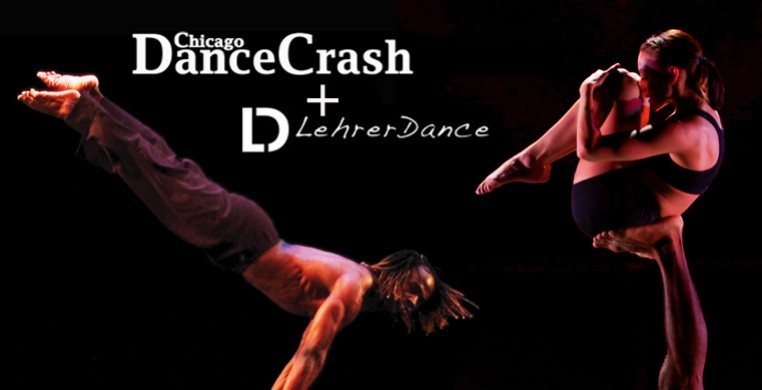Chicago DanceCrash and Chicago transplant Jon Lehrer’s Buffalo-based LehrerDance shared the stage at the Athenaeum Theatre Saturday night in a program that highlighted both the similarities and differences of the two companies. Similarities include an upbeat, athletic style of mostly fast-paced jazz/contemporary fusion. Gymnastic pyrotechnics also feature in much of the choreography of both companies. Each can boast handsome, well-trained and polished ensembles that entertain with technical skill and authority, and a certain “WOW!” presentational dynamic. It’s easy to understand how DanceCrash found Lehrer’s choreography appealing enough to include in their repertoire last season and to forge an east/mid-west relationship that promises future collaborative efforts.
Significant differences gave the program variety of movement, style, and subject matter. Where DanceCrash veers toward the more popular cultural idioms in choice of music, choreographic structure, and theme, LehrerDance references classic modern dance vocabulary, structure, and use of breath and weight, and an eclectic range of music and themes.
Opening with DanceCrash and alternating companies throughout the program, the six pieces included two works by DanceCrash artistic director Jessica Deahr, three by Lehrer, and one piece for DanceCrash by freelance dancer/choreographer Ben Wardell.
Deahr’s “Hum 8 Bars” sent DanceCrash on a playful acrobatic romp to familiar vintage rock n’ roll tunes with handstands, cartwheels, and partnering stunts worthy of “Dancing With the Stars.” The feel-good performance showed off the company’s high energy and technical strength in a series of commercially slick sequences without any real structural development, and ended in an arbitrary non-ending.
Lehrer’s “Femeie De Lume” (2014) used ever-shifting sculptural formations of three bare-chested men in ritualized movement that variously supported and paid homage to a goddess/sacrificial virgin figure. Lehrer’s sensitive use of liturgical music by Vivaldi and Einaudi contributed to the ceremonial feel of the piece that had tiny Colleen Walsh, dressed in nothing but a scant white bathing suit, rising like the phoenix out from the men’s embrace. Her initial wobbly trajectory across their backs suggested insecurity that wasn’t born out in subsequent movement motifs, which were otherwise deliberate and highly stated. Lehrer’s use of human bodies as scaffolding for level changes sustained visual interest, while thematic use of opposition in attenuated pulling and reaching movement reflected the mournful lyricism of the music.
Deahr’s “The Generator” propelled humanoid mechanicals through breakdance moves with maximum punch to electronic static and techno-pop music. The stripped upstage wall of exposed brick provided the perfect decor for this apocalyptic perpetual motion machine, but the non-stop movement wore thin with overly repetitive, unvaryingly harsh dynamics.
“Cash or Check” (2014) was Lehrer’s saucy concession to 1920‘s and 30‘s popular dance. The fluid, athletic movement took off in couples dancing with strong core movement and lush combinations that utilized the space in contrasting men’s and women’s group patterns. Terrific partner dancing made this piece both smart and fun, musically exciting and spatially arresting.
Ben Wardell’s “Can’t Hardly Stand It” for DanceCrash interpreted the music's lyrics--”she’s not there” and “bang bang, my baby shot me down”-- with repetitive, literal gestures depicting the ups and downs of relationships, with both earthbound and aerial coupling. Group patterns of walking and running exits and entrances gave a sense of the transitory nature of connections.
The strength of Lehrer’s ”Pantheon Rising” (2013) is in the spatial design he achieves with fluid group movement. The ensemble has the Star Trek-y feel of a brave-new-world mission, with a relentless musical pulse that is less interesting than his other musical choices, but adequately serves the strong unison movement here. Men lifting men, women lifting men, and a running leap into a tour en l’air that gets plucked out of flight by a second dancer’s split-timed catch created visual excitement. Lehrer’s musicality and facility with contrasting group patterns are hallmarks of his work. In this piece, leaning more toward popular jazz dance than contemporary in concept, style and movement invention, traded depth of thematic development for mass appeal, of which there was plenty.
In the end, the two companies joined each other on stage, ramping up their joy of dancing quotient to the hilt. The curtain call for the combined companies was the most fun of all, as each dancer got a chance to shine in his or her own unique way. And what rich assets these dancers displayed; enough to give any choreographer new ideas. Collaborations can have that effect.

